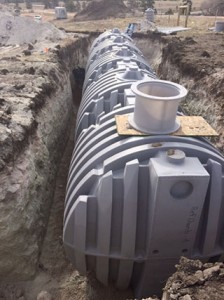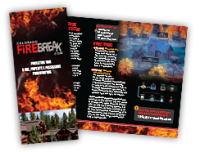Q. How does it work?
A. Colorado FireBreak is a customized system that quickly delivers a fire suppression product called FireIce to cover structures and surrounding trees and vegetation. This not only protects the structure, but helps to create a firebreak. Fire that is progressing through the tree tops, over the ground, and even floating as embers is inhibited. See a demo video of how Colorado FireBreak wildfire protection works here.
Q. What does the system cost?
A. The level of protection is governed by your budget. Our systems are customized to your particular property, its topography, and the size of the area you want to protect. The more expensive systems also offer a greater level of automation. Installed basic systems start at $14,000, and more complex systems could be more than $100,000.
Q. Will this increase the value of my home?
A. In many areas of Colorado that are at risk for wildfire, a Colorado FireBreak system could be expected to be a major selling point for many buyers.
Q. Will my homeowner’s insurance rates go down?
A. Since this is a new product, many insurance companies are now looking at how it mitigates risk for wildfire destruction. We expect that many insurance companies will offer a discount to those with this protection. Contact your insurance agent for more information.
Q. What should I be thinking about when I am looking for a solution to protect our home?
A. Wildfires are very unpredictable and applied methodology is very important. Our systems were designed not for best–case-scenarios but worst-case-scenarios like:
- What if fire personnel cannot get to your home to protect it? Could your existing fire protection withstand a wildfire for 30 minutes or more? Could it withstand a barrage of embers? Could it withstand a firestorm?
- Fires are known to move as fast as 60 MPH with temperatures of more than 1000 degrees. What if a fire protection system was deployed prematurely? How would a single deployment protect 1 hour later, 3 hours later or 8 hours later?
- If deployed as in a fire storm would the application of fire suppressant be able to kill the fire on contact without re-igniting?
- Does your fire suppressant protect against radiant heat on windows, prevent a fire from reaching your home? Extinguish embers before reaching the soffit vents and automatically close soffit vents?
Colorado Firebreak is designed to offer protection for all of these circumstances.
Q. What is FireIce?
A. FireIce is an environmentally-friendly powder-like substance, that when mixed with water, becomes a gel. This gel can coat wood or other substances, making them fire-resistant even when exposed to fires over 2000-degrees. FireIce acts both to put out the fire and dissipate heat, protecting your home and surrounding property wherever it is applied. In the Colorado FireBreak system, it is mixed with an appropriate amount of water and sprayed where needed for greatest protection. FireIce is not toxic to humans, wildlife or pets. In fact, you could eat it with no harmful effects. Once the fire danger is over, you can clean it off with a water spray.
Q. Why does FireIce outperform Class-A foam or water alone?
A. Many Class-A foams are corrosive, and some are even toxic. As a result, many families would prefer to avoid them entirely. Many Class-A foams dissipate and break down too quickly to provide protection following a fire evacuation. FireIce requires far less water to activate it than Class-A foams. This is a major consideration for many mountain communities where the availability of water during a wildfire is limited.
Water alone can tame fire, of course, but it takes a lot of it. A University of Minnesota study found that it takes water to a level of 1 inch over 24 hours to provide any real resistance against fire. In a wildfire event, it would be unusual to have that much time—or water availability. Water evaporates way too fast leaving the structure and windows venerable. The video below shows that water can lower temperatures slightly and tame a fire for a short period of time but FireIce lowers temperatures drastically and kills the fire.
The other advantage of FireIce is in protecting windows. Often the heat of a wildfire causes windows to explode, which makes the interior of the building subject to flying embers. Unlike water or Class-A foam, FireIce gel will adhere to window screens and dissipate heat enough to maintain the integrity of the windows and protect the interior.
Water can tame fire. FireIce Kills it: Quickly, Efficiently, Permanently.
FireIce to water comparison:
FireIce to Class-A foam comparison:
Q. Is your system environmentally safe?
A. Yes. FireIce is a product that hydrates naturally. It is non-toxic, non-corrosive, and actually good for soil and plants, helping to keep them hydrated in our dry climate. FireIce has been approved by the United States Forestry Service as non-threatening to the environment.
Q. Is it easy to clean up?
A. Yes. Just rinse with water. As a hydrogel, it can remain on trees and plants, as it actually helps them retain moisture.
Q. How is the Colorado FireBreak system activated?
A. Colorado Firebreak offers more than a fire retardant spray system. With our automated systems, the fire suppression is activated by sensors that “see” the fire or embers coming, and send signals to a proprietary controller. The controller starts a series of steps including mixing the FireIce with water, closing soffit vents, and coating areas to be protected with the FireIce. All work together to layer protection where needed.
Q. I live in a suburban neighborhood, a Wildland Urban Interface. Is this system appropriate for homes that are in close proximity to one another?
A. Yes. It is intended for homes and businesses in areas either rural or those considered wildland-urban interface. In fact, the system could be set up to create a firebreak of sorts for a group of homes at a shared expense.
Q. Do I need a building permit?
A. Some jurisdictions may require a permit. If so, Colorado FireBreak will pull the permit needed. Our team includes master plumbers and master electricians, and we hold Class B and C contractors licenses.
Q. Who installs the system?
A. A Colorado FireBreak team installer.
 Q. I am a builder. Can multiple homes share elements of the system?
Q. I am a builder. Can multiple homes share elements of the system?
A. Yes. There is often an economy of scale that can be used with multiple homes or structures. They may be able, for example, to share a water tank. It depends upon how close the homes are to each other.
Q. I already have a large cistern. Can we use that?
A. If you have a cistern large enough for adequate water supply to the home, we can use that, and deduct that part of the cost of the system.
Q. I have my own generator. Can we use that?
A. We may be able to use it. If it is reliable, has an electronic transfer switch and the amps required to start and run our system, it may be all that you need.



